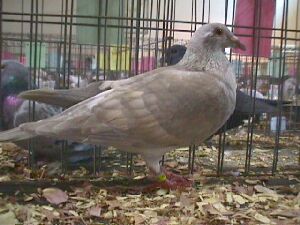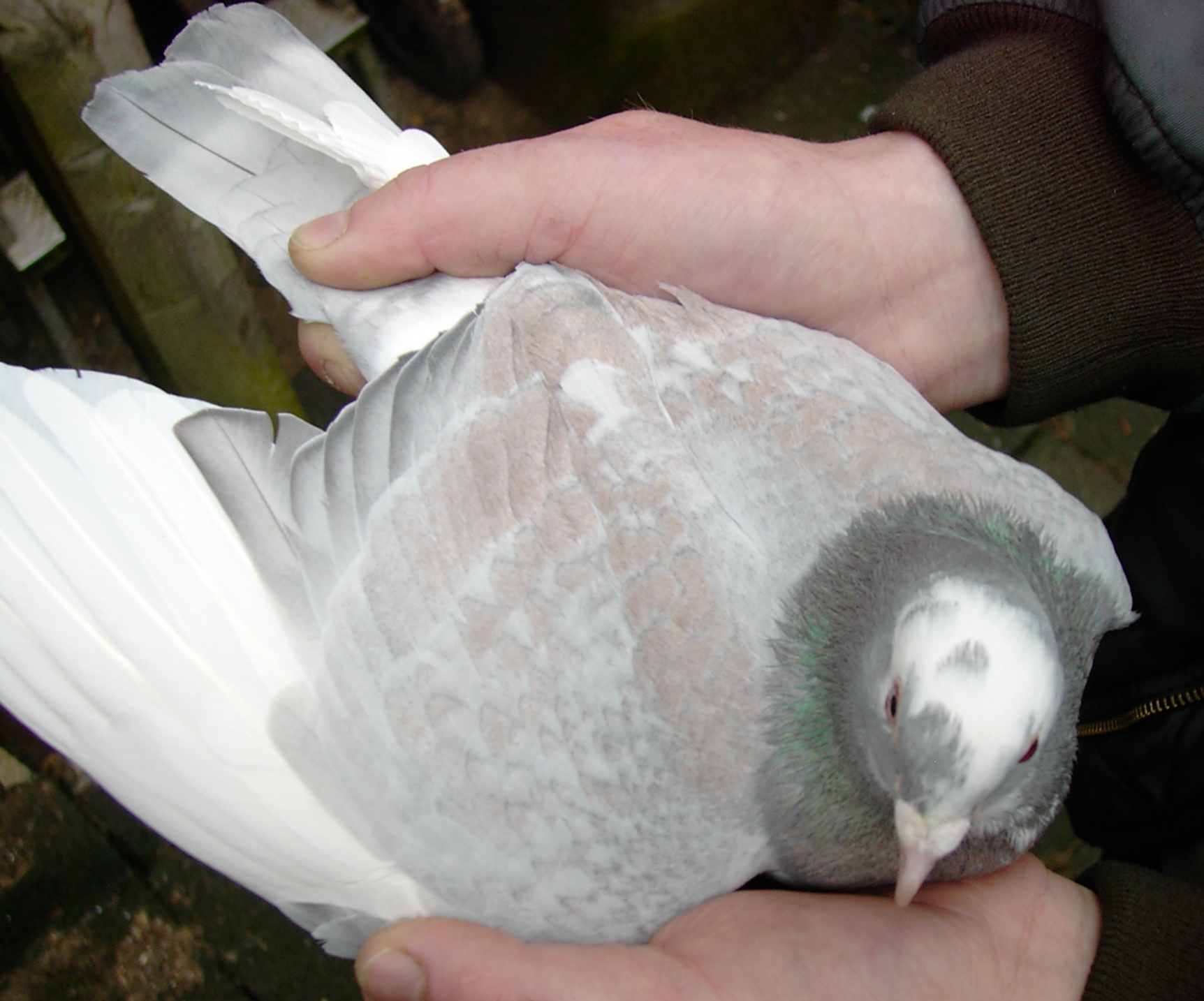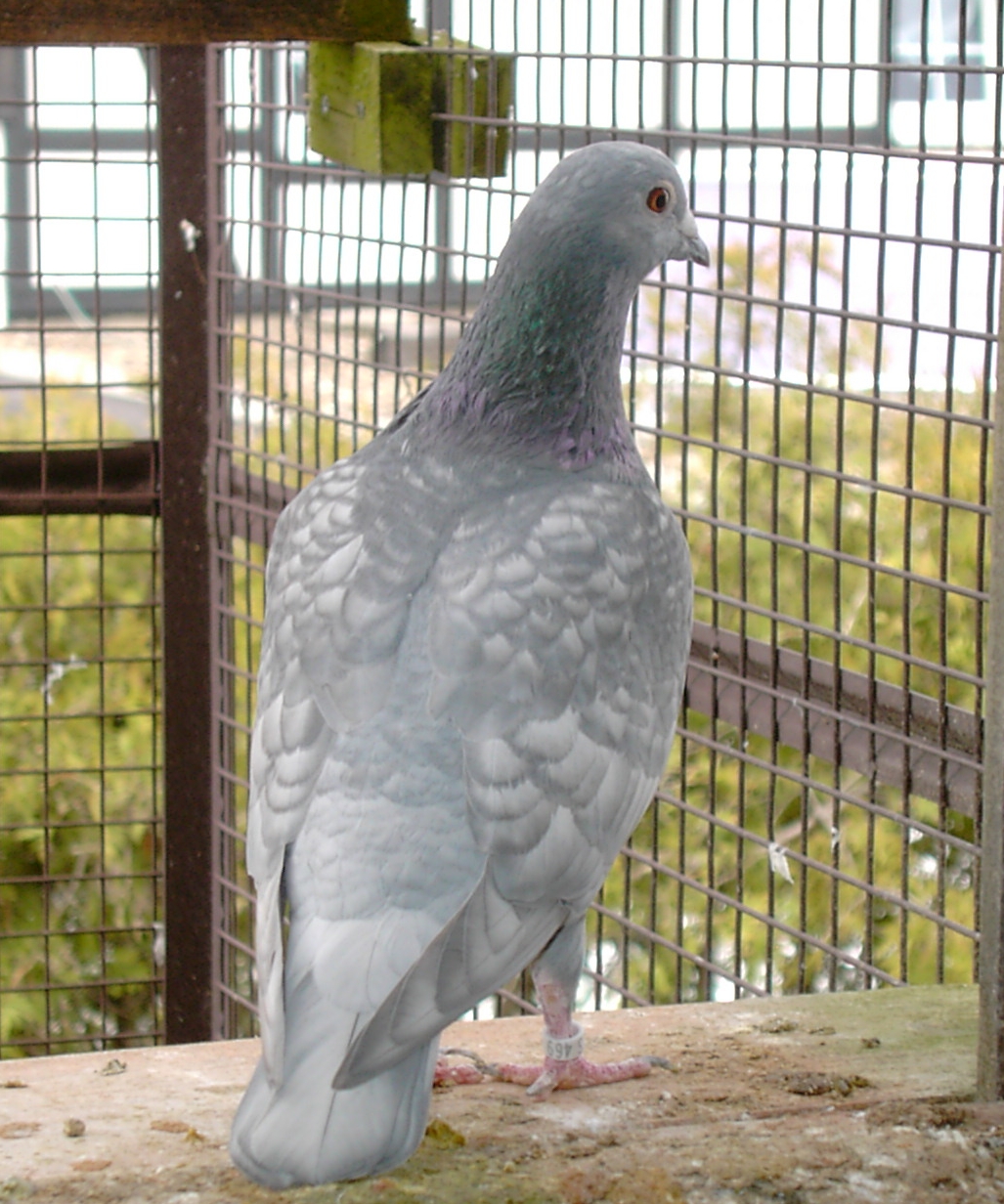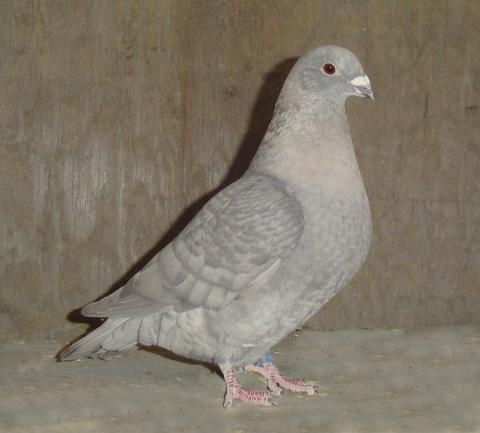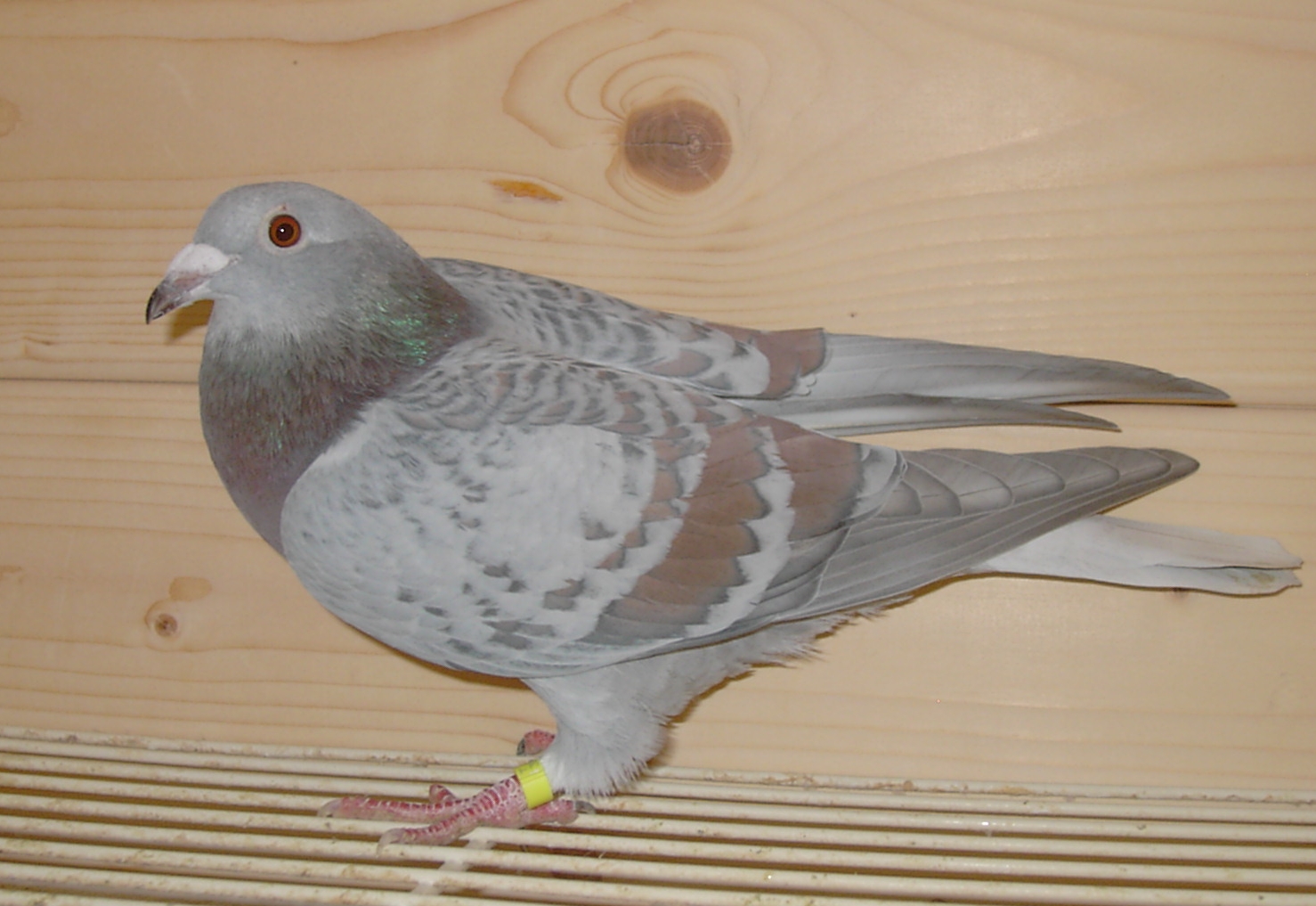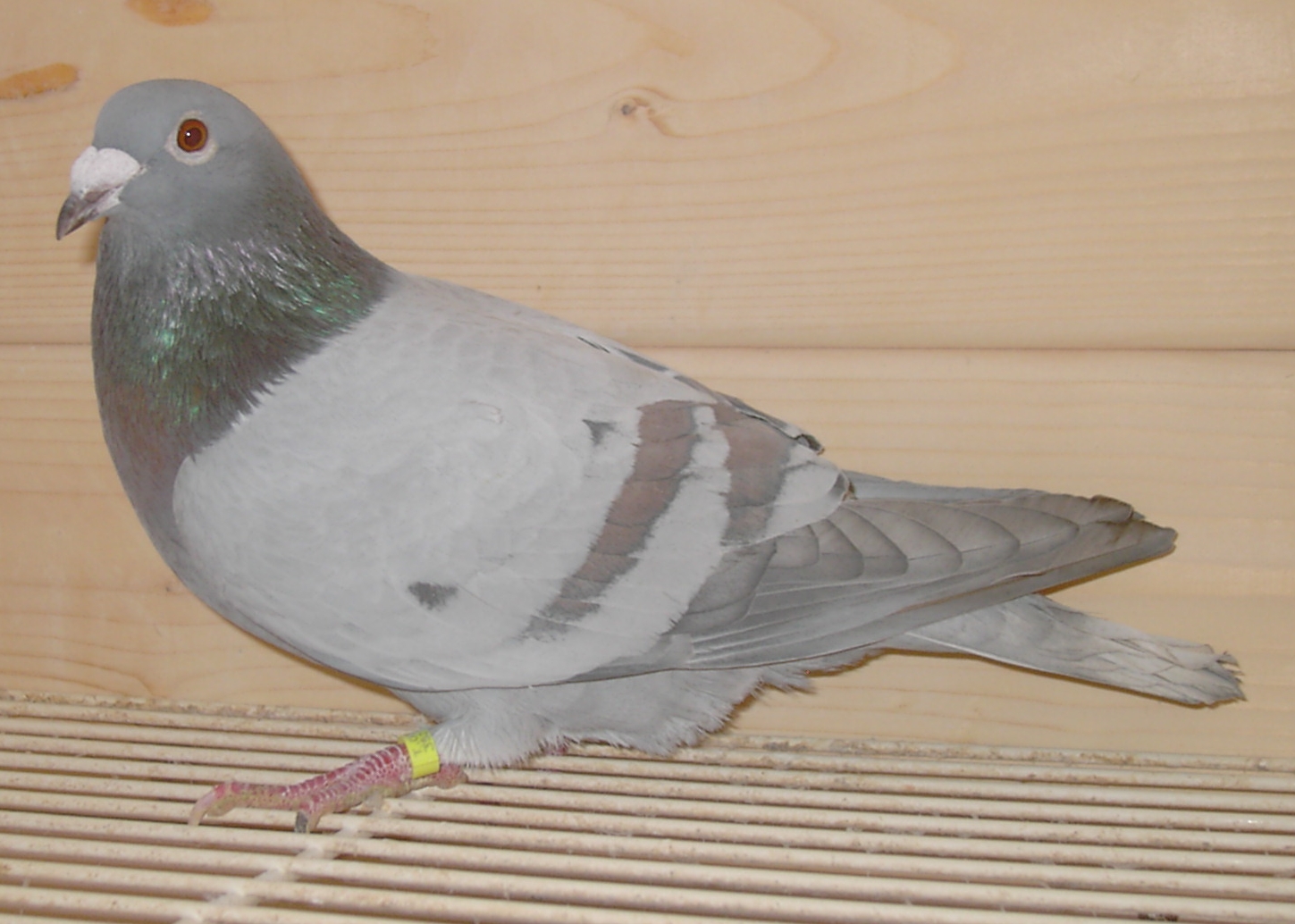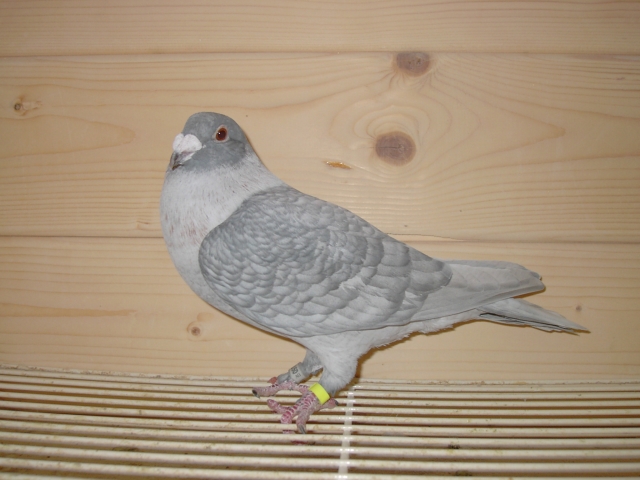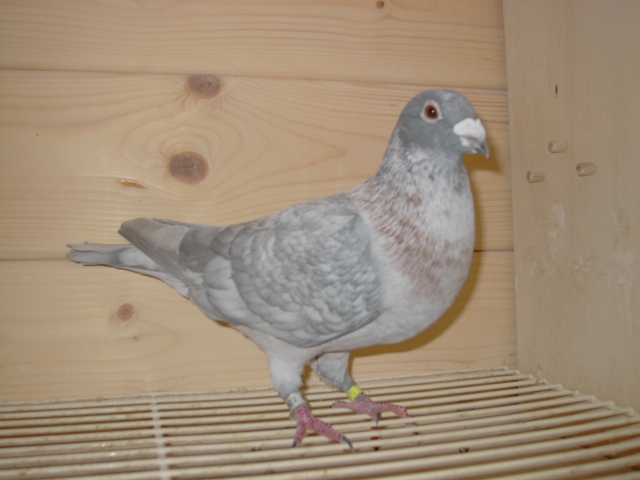Reduced (r) and Rubella (rru)
Reduced
and
Rubella are two rare color modifiers that share the same genetic
location on
the Z sex chromosome known as the r locus. Actually there are
three
possibilities at this chromosomal position but of the three only these
two are
considered uncommon. The more common of the gene
possibilities found at
this location results in a display of normal color intensity or what we
call
wild type. This page deals only with the much rarer
occurrences of
reduced and rubella. Of these, the first (reduced) originated
in flying
roller in the USA and has subsequently been moved into several other
breeds;
while the other, (rubella) has only recently been found in German
racing
homers. Like reduced, rubella is now slowly finding its way
into other
breeds; at the hands of various color breeders.
The
following
is an excerpt from Joe Quinn’s "A Pigeon Breeders Notebook" c
1971. It is an excellent book which I highly
recommend. Every
student of pigeon genetics should have a copy.
"A
boy
whom Carl Graefe had helped with a start in rollers, brought
him a pair
of birds and asked Carl , "What color are they? " Carl
answered, "I don’t know." The chance
mutation, coupled
with the odds against it being reproduced in a homozygous cock, seems
fantastic, when we consider that the pair is presented to one of the
few men
who might recognize their value. An attempt was
made to trace the
birds, but to no avail." However
from these first few, all pigeons
that today carry the reduced color go back to these original
birds.
As
I previously
stated, rubella was recently found in a German racing fanciers loft.
To
my knowledge, only a handful of rubella pigeons have been imported
to the
United States, Dr. Paul Gibson being the primary source and point of
contact.
I had one gifted by Dr. Gibson but she escaped before I could breed
from
her. My plan was to put her with my reduced homers and study
the slight
differences between the two alleles. Sometime later Paul gave
me another
but this cock was to old to continue breeding. Perhaps
someday I’ll get
another chance.
Note
in the
case of Reduced (r) and Rubella (rru)
only lower case letters are used. Genetic symbols in
lower case always denote recessive traits while an uppercase symbol
would
denotes a dominant. Reduced and rubella are both recessive to
wild type.
Since reduced was discovered first, the locus where the two
reside was
named for the reduced gene, i e. the r locus. Since reduced
is recessive
to wild type, both the locus point and the gene are symbolized as lower
case r.
Now along comes the new genetic find of rubella and we
determine that it
is an allele of reduced. Well, we must give it a symbol and
since it is
at the r locus this symbol must start with a lower case r and receive a
superscript to denote its name and dominant or recessive
characteristic.
As it turns out the letters ru were selected for rubella and since it
is
recessive to the reduced gene at the r locus the superscript letters ru
will
also be written in lower case. Had rubella been dominant over
reduced the
superscript letters would have been capitalized.
In that case, the
genetic symbol would be (rRU)
and not the (rru)
that we
use today.
That
is
very interesting you say but what does it all mean.
Well for
starters since reduced and rubella are both sex linked genes on the Z
or sex
chromosome only a cock bird can be heterozygous for each possibility
i.e. r// rru
and should that occur
the bird will always express as a reduced and not a combination of the
two.
What
follows is a brief description of reduced (r) and rubella (rru).
Photos
for the rubella homers were submitted by my friend Jens Stinner of
Birken
Germany www.seltenfarbige-brieftauben.de.
Photos of some of the reduced birds were taken at
my loft in
Georgia before moving here to Duncan South Carolina. Others
are as
noted. Since reduced is the first of the two noted, lets
begin with its
description.
![]()
|
Reduced Reduced
lightens the intensity of pigment by reducing its
amount. On a basic blue color pigeon, the reduced factor
produces
numerous pastel pink and or buff colorations for the birds various
marking
patterns. The reduced mutation was first
noted by Carl Graefe
when a young boy brought a flying roller of strange color to him asking
what
its color was. Carl being a keen student of pigeon genetic
knew that this
was something new and retained the bird for further study and breeding
tests. It was he who gave it the name reduced.
The other two
alternatives for this gene are intense i.e. non-reduced wild type (R+),
and rubella (rru)
which is a new
European mutation which is discussed below. In other words,
both reduced
and rubella represents a change from the normal intensity for pigment
to
lighter amounts.
A
reduced blue bar left, with reduced white bar on the right A
reduced blue bar has
all its color pigments reduced with the effect of turning the blue into
a gray
cream while the bodies normal black markings become a pink/rust like
color.
What normally is a black tail bar fades into a gray.
The birds hackle
or neck a bit darker than the wing shield with a pinkish green luster.
A pastel metallic cast is often seen and
desired.
Compare the metallic look around the head and neck the birds above with
the
more normal blue look of the rubella blue bar shown below.
Also note the
faint white bars on the above bird on the right. Not sure why
this
difference but I do know this hen also carries the modifier know as
dirty
(V). This may account for the difference in
phenotype. Reduced like
so many other color modifiers needs more conclusive study. Reduced
blue check
This
bird here, a hen,
is a splashed blue checker reduced with white flights. She is
a good
example of reduced blue with the typical pinkish hue for
pattern marking
and gray tail with slightly darker tail bar. Also note the
metallic color
of the neck. Photo provided by Jens
Stinner.
Reduced
blue t-pattern or velvet left, reduced blue white bar
right. Have
you noticed the
normal black wing shield pattern markings are modified by reduced to
display as
a very pastel pink color with light gray tail and under side.
The more
pattern displayed the more pastel pink seen. Both cocks and
hens are very
striking in color. Reduced
can also be
variable with some displaying white bars similar to that found with
dominant
opal. See photo upper center. White bar reduced
patterns do occur
and are normally healthy birds; however, there are exceptions with
white
bars. My experience has been that a reduced white
bar with white
tips on the ends of both its wing and tail feathers along with a white
head cap
will be a very weak bird and live no more than six months.
Why, I do not
know, but I believe it’s the result of combining this
mutation with other
mutations that when mixed weakens the birds system resulting in an
early
death. For this reason, I do not recommend combining reduced
with other
color modifiers such as dilute or opal.
Reduced
blue spreads or what some would call reduced black.
When
in combination
with spread, see photos above, a reduced blue will have a phenotype
very
similar to that found with spread blue dominant opal or spread blue
recessive
opal or even spread blue rubella. At first glance it is very
difficult to
distinguish between them as they all display that dark lacing effect on
the outer
edge of the feathers. The bird on the left is from
Jens
Stinner of Birken Germany
;
the other, on the right is by Karl Rau , Rare
Color Homer Loft of Maine.
Now
let’s turn our
attention towards rubella, the other mutation in this series.
In my
search for information I have only been able to find one article that
explained
how rubella was found and how it relates genetically. It was
originally
published in German by Gerhard Knopf who is, I believe, also
responsible for
the genes discovery. My friend Hans Windgassen, a
retired high
school art teacher and pigeon flyer made the original English
translation for
the article and I added a few slight modifications and updates as
posted here. |
Rubella
- A New Color Mutation by Gerhard Knopf German
breeders of racing pigeons normally select for homing ability and
flight
performance. For them, color varieties are of secondary
importance.
When a strange or odd color does occur, its labeled "Fehlfarben"
which translates to miss color or odd color and its genetic makeup is
of no
concern to the breeder. Normally the reason for such odd
colors is the
combination of multiple genetic modifiers working in concert with each
other to
produce an odd or uncommon color phenotype. It is seldom that
the genetic
makeup cannot be traced back to a known genetic source or group of
color
modifier. On rare occasions, however; there are
some that cannot
and these are often the result of a new mutation.
The
bird was a
hen. A stronger coloration occurred after the molt.
I assumed it
was recessive opal, as both parents were of the blue/black base color
with a
well-expressed tail bar. A mating of this assumedly
recessive opal
bird to a known recessive opal cock (all test matting done in isolated
cages)
did not result in opal as expected but in normal blue progeny.
This pointed to the phenomenon or
possibility that differing
genes existed among some racing homers which could produce a recessive
opal
phenotype or mimic in appearance. This in turn led
to further test
matting of three successive generations, details of which I will not go
into
here. The
results of these
test matings led to the conclusion that the new mutation was a
recessive gene
and that it is located on the sex chromosome. The effect of
this gene on
adult birds is as follows:
Photos
for the rubella
homers were submitted by my friend Jens Stinner of Birken Germany.
www.seltenfarbige-brieftauben.de
Because
this phenotype
is so similar to birds with the reduced color gene including those in
combination with spread, it was obvious that a test mating had to be
done to
learn if they were somehow related. The results
clearly show that
both reduced and rubella are alleles of each other, and that of the
two,
reduced is the more dominant! This
surprising and
fascinating discovery ended here with the selection of a
name. Since opal
and rubella are related and since the stone known as Opal has a glassy
metallic
sheen that reflects light in many colors the name "Rubella" was
chosen. Rubella is a red-brown mineral without
metallic sheen, whose
variation in color tone or nuances is similar to that of the described
checker
and bar coloration. In
keeping with the
proper selection of genetic symbols the lower case symbol rru
was given to denote a recessive gene at the r locus. At this time and according to contemporary research, three alleles occur on the sex chromosome among pigeons for the so called b-series or base colors. They are (b) for brown; (B+) or simply (+) for wild type blue/black; and (B A) for ash red. The many color modifiers also found on the sex chromosome include the ST series with the Almond factor (ST) and its alleles [Hickory (STH); Qualmond (STQ); Faded (STF); Sandy (STS); Frosty (STFr ) and Chalky (STC)]. The d-series with the dilution factor (d) and its allele pale (dP) pale and extreme dilute (dex); as well as the r-series with the reduced factor (r) and its new found allele rubella (rru) may also to be found theer. By Gerhard Knopf.
Interested
breeders
may contact the author Gerhard Knopf at: Alter Uentroper Weg 253, 59071
Hamm,
Germany Gerhard Knopf Again
I would like to
thank both my friend Hans Windgassen for his work in translating the
above
article and Jens Stinner of Birken Germany
www.seltenfarbige-brieftauben.de
for
the wonderful photos of his rubella birds. Now to bring this to an end, we have another very nice Rubella blue check submitted by Arnau Constans of Spain. Note how similar this bird is in phenotype to a recessive opal. While Rubella and Recessive opal when on the basic color of blue may look almost identical, genetically they are miles apart. Rubella being a sex-linked recessive and recessive opal being an autosomal recessive. The differences between a sex-linked recessives and an autosomal recessives is in the way they are passed on to their offspring. Each follows a different set of rules in the process and outcomes.

|
Permission is granted to download or copy for non-commercial individual use only.
The author retains all other rights under copyright.
Web Page Designer
Duncan SC, 29334
